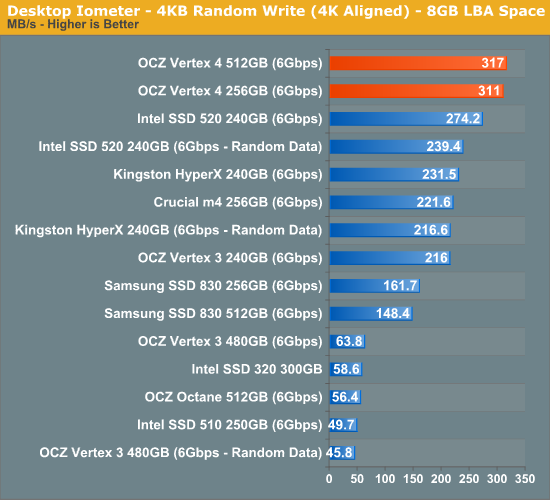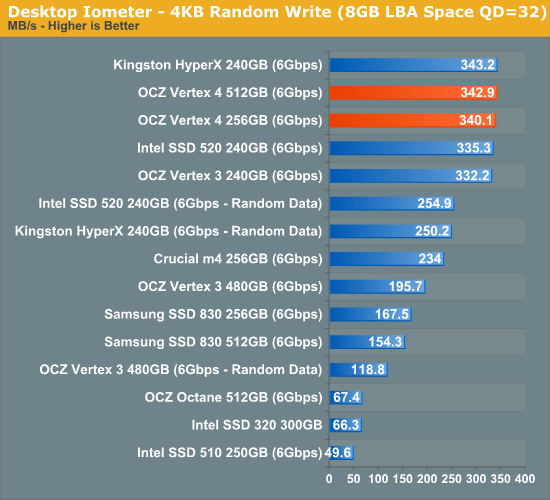OCZ Vertex 4 Review (256GB, 512GB)
by Anand Lal Shimpi on April 4, 2012 9:00 AM ESTRandom Read/Write Speed
The four corners of SSD performance are as follows: random read, random write, sequential read and sequential write speed. Random accesses are generally small in size, while sequential accesses tend to be larger and thus we have the four Iometer tests we use in all of our reviews.
Our first test writes 4KB in a completely random pattern over an 8GB space of the drive to simulate the sort of random access that you'd see on an OS drive (even this is more stressful than a normal desktop user would see). I perform three concurrent IOs and run the test for 3 minutes. The results reported are in average MB/s over the entire time. We use both standard pseudo randomly generated data for each write as well as fully random data to show you both the maximum and minimum performance offered by SandForce based drives in these tests. The average performance of SF drives will likely be somewhere in between the two values for each drive you see in the graphs. For an understanding of why this matters, read our original SandForce article.
Random read performance is staggering - a good 40% higher than anything else we've tested. While the cutoff for usefulness on a client drive is likely much lower than what even the Octane could deliver, this sort of performance bodes very well for OCZ's enterprise ambitions.
Randomly write performance is also just excellent. SandForce's peak numbers come close, but throw in any sort of incompressible data and they quickly take a step back while the Vertex 4 is able to deliver. Again, I'm actually more interested in these numbers from an enterprise workload standpoint but heavy client users will definitely not be disappointed.
Many of you have asked for random write performance at higher queue depths. What I have below is our 4KB random write test performed at a queue depth of 32 instead of 3. While the vast majority of desktop usage models experience queue depths of 0 - 5, higher depths are possible in heavy I/O (and multi-user) workloads:
SandForce always scaled well at higher queue depths, but again we're looking at best case performance for the SF-2281. Move towards incompressible data and the Vertex 4 is alone at the top.













127 Comments
View All Comments
rw1986 - Friday, April 6, 2012 - link
This seems very speculative. OCZ has admitted collaboration with Marvell (for example on their new Kilimanjaro platform for the Z-Drive R5 PCIe SSD).here is the link to the OCZ Everest 2 announcement: http://www.ocztechnology.com/aboutocz/press/2012/4...
In the announcement, OCZ makes some specific claims surrounding Everest 2 -- for example:
"the Everest 2 SSD controller reduces latency to 0.043ms for read operations and 0.026ms for write operations, yielding an improvement of approximately 80 percent over the previous Everest SSD controller generation"
"The advanced, multi-level BCH ECC engine with progressive error correction adapts to the specific error characteristics of different NAND devices. The programmable ECC engine achieves an effective correction power of up to 128 bits per 1KB of data while significantly reducing the uncorrectable bit error rate (UBER)."
The Marvell sheet emphasizes some similar things (high performance, error correction technology) but these are more general claims than what OCZ has listed in their Everest 2 spec sheet.
Is the foundation of your assumption that Everest 2 is just the 88SS9187 that the spec sheets sound similar? That does not seem conclusive to put it generously
jwilliams4200 - Saturday, April 7, 2012 - link
There is no hard evidence that is publicly available since OCZ is keeping it quiet for obvious reasons.The Octane uses a rebadged Marvell 88SS9174, and the Vertex 4 uses a rebadged Marvell 88SS9187.
rw1986 - Saturday, April 7, 2012 - link
I'm just curious how you can make these claims so authoritatively when, as you say "there is no hard evidence that is publicly available" to support your position.What you seem to be suggesting is that OCZ made a 32 million dollar acquisition in April of 2011 (Indilinx) and then decided to simply license and rebadge controllers from Marvell rather than build internally (which is completely contrary to what OCZ has told investors and the public). On a Thursday conference call OCZ's CEO was quite adamant that Everest 2 is completely their IP and will improve their profit margin strucutre as a result (since they don't have to pay a fee to Sandforce for each controller as before). If what you are saying is true then OCZ has misled their investors at best.
This is a pretty serious accusation you are making here and it would be nice if you had a little more to say in support of it than "trust me, i know." If you were really in a position to know then I doubt you would be posting on the comments section at AT.
I'd be interested to hear some experts weigh in on this exchange. How could we verify or disprove that the Everest 2 is really not Indilinx but instead a rebadged 9187? Surely some analysis can be done on the ASIC
jwilliams4200 - Saturday, April 7, 2012 - link
It isn't very important to me either way, since I have no financial interest. But OCZ has a history of dishonesty, and it bothers me to see them get away it.If it is important to you, you could start by contacting the appropriate people at OCZ and asking whether the controllers in the Octane and the Vertex 4 have similar or identical circuits with Marvell controllers.
jwilliams4200 - Wednesday, April 11, 2012 - link
http://www.anandtech.com/show/5741/ocz-confirms-oc...hackztor - Friday, April 13, 2012 - link
Good job on being correct. I think alot of people feel betrayed again by ocz. Last time i will purchase their product no matter what.pookguy88 - Wednesday, April 4, 2012 - link
so wait, right now they'll (256gb, 512gb) ship with 1gb DRAM but later on 512mb? Is it just me or is that going to be a huge deal for customers once they realize that they basically got jacked 512mb of RAM vs early adopters?pattycake0147 - Wednesday, April 4, 2012 - link
I inferred that the smaller drives will ship with 1GB but only 512MB will be used on the drive.Voo - Wednesday, April 4, 2012 - link
Considering that was explicitly stated in the article there's not much to infer here is it?"Oh no I was jacked from 512mb that were deactivated anyhow - what a scandal!"
antef - Wednesday, April 4, 2012 - link
Why is your standard recommendation still the Samsung SSD 830? Given the performance, prices, and most notably, the incredibly excellent reviews on sites like Newegg, the Crucial M4 would still be my recommendation to new shoppers.